Dans le n° 69 du bimestriel "Bourgogne Aujourd’hui", sous la plume de Laurent Gotti, une interview de trois pages ! avec de magnifique photos sur ma passion pour les vins anciens et sur l’académie.
Un article dans le Financial Times dimanche, 2 avril 2006
Dans le numéro du 2 avril, il y a un supplément mensuel du genre "art de vivre.
Un article parle des dîners avec des vins anciens. Le texte me concernant est le suivant :
"Yet another variation on the wine dinner theme can be found in France where the delightful French collector and bon vivant François Audouze continues to organise his extravagantly hedonistic – yet immaculately discreet wine dinners for like-minded epicureans. Formerly the CEO of steel company Arus, Audouze was looking for a way of sharing his passion for wine and food and hit upon a remarkably simple concept. Every month, Audouze’s website invites nine paying guests to an undisclosed two- or three-Michelin starred restaurant in Paris where he and they will enjoy 10 rare and exquisite wines from his magnificent personal cellar. (His pre-1945 collection alone accounts for over 10,000 bottles. “Younger” vintages are even more plentiful.)
Audouze not only hosts his hedonistic dinners (which usually cost just under € 1,000 / about £580 per person), he also selects the wines (and to an extent the food) so that not two events are the same. The result is a truly eclectic mix of wines and venerable old vintages. For instance, the dinner in January included an 1893 chateau Guiraud, a Nuits Saint Georges from 1915, a 1938 Mouton Rothschild and a 1954 Cos d’Estournel. All of which made Domaine de la Romanée Conti 1976 Grands Echezeaux and the ’82 Salon look positively infantile in comparison.
Audouze started his dinners about five years ago and now offers tailored events for companies too. As a result, his dinners attract aficionados from all over the world. Mostly, though, the people who attend tend to be men. “but at our next dinner we have four women, which I like. If it is all male, it can turn into a combat de coqs which I would rather avoid”, he adds.
Unlike most wine dinners, Audouze never does themes that focus on a single vintage or chateau. “Partly, this is because it then becomes an intellectual exercise about which wine is best”, he says. “Instead, I want people to enjoy and understand the wines rather than judge them. So my rules are simple. If you know something about wine – forget what you know. And if you think you know nothing about wine – forget that too”. Certainly, his dinners have occasionally been known to upset the form guide. “Once, we ranked a 1947 Moulin à Vent Beaujolais above a 1934 Latour”, says Audouze. ‘I love it when that happens, because it shows just how surprising and exciting wine can be”.
Ce n’est pas mal du tout.
La revue : Financial Times du 1 et 2 avril, supplément mensuel "How to spend it" avril 2006, page 66/67.
a lunch on a beach, in the sun, a promise of Summer dimanche, 2 avril 2006
With my wife, we went a week ago to Marc Veyrat in Megève.
I will make a subject about this lunch, as we explored wines of the Rhone, some of them being magnificent.
Marc Veyrat is a genius. I was wondering if a new experience would make me as happy. I was.
Then, I drove to my house in the South of France, in a lovely place on the sea. For the week, no drop of wine was on my planning.
But friends announced that they would come to visit me, and we went to a small restaurant which is one the rare places installed directly on the strand. They have put tons of white sand, so the place has an atmosphere of a small Saint-Tropez, the prices in less and the top models in less. But the place is charming. The name : “Le Day” in Hyères, near the airport, on the beach.
Last year was their first installation and they had a good idea to have Dom Pérignon and Cristal Roederer for affordable prices. They had reopened the day before, so their cellar was nearly zero.
I asked them to go and buy wine as I would come back with friends. And they promised me that they would have nice fishes.
We began with a Cristal Roederer 1999. I must say that I was very disappointed by this champagne that I found too “dosé”. Much too sweet for me. I would be happy to receive comments : am I wrong ?
Fortunately, the waiter came with huge plates of urchins (offered), and with the sweet taste and iodine taste of the urchins, it went largely better. But, I was disappointed.
Then a Blanc de Blancs Domaine d’Ott 2003. I am always hesitant when Ott is concerned, because Ott is a “must” as Dom Pérignon is a must. So, I am always cautious. But I must say that I was bluffed by this wine which was extremely intense, deep and with a great personality. I had it on a Carpaccio of salmon. I have loved this wine.
Then on a sea bream, I had ordered a Bandol, Chateau Salettes red 2003. Very nice, but largely less convincing than the white. And after that, a Chateau Jasson red Cotes de Provence 2004 was promising, but largely too young for me.
Such a lunch on the beach with a little wind but much warm sun is a promise for Summer.
I enjoyed the Ott.
A nice day.
un achat, chat en poche, se révèle un bel achat vendredi, 31 mars 2006
Achat, chat en poche !
Je reçois environ 10 / 15 offres par semaine de vins à vendre.
Généralement, je réponds : « la valeur gustative de vos vins étant supérieure à la valeur financière, je vous conseille de les boire ».
Un jour, quelqu’un me propose des Frédéric Lung, Royal Kébir, vin d’Algérie.
Là, stop, on cause.
Le vendeur me dit qu’il a une caisse en bois de Lung, et que ce doit être des années 50, et qu’il doit y avoir 4 rouges, 4 blancs et 4 rosés.
Je formule un prix en disant : sous réserve de les voir.
Nous avons rendez-vous à Hyères, sur le port, et je découvre cette caisse. Monsieur est venu avec madame, et ce couple de retraités est évidemment inquiet de savoir si la transaction se fera.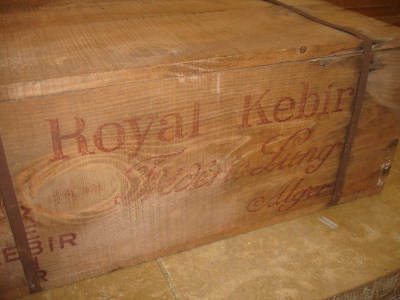
Je demande si on peut ouvrir et le monsieur me dit : « vous n’y pensez pas. D’ailleurs, pour un collectionneur, c’est la caisse entière d’origine qui a de la valeur ». Quand je lui dis : « mais c’est pour les boire », le monsieur se dit que je dois être un fada.
Nous récapitulons ce qu’il me vend, chat en poche donc : quatre bouteilles de chacune des couleurs, années 50.
Je reviens juste d’avoir ouvert la caisse :
– quatre rosés sans année, bruns comme des figues sèches, d’excellent niveau
– huit rouges 1945 dont une seule est haute épaule, les autres dans le goulot.
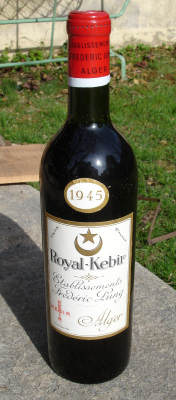 Bingo !
Bingo !
J’ai déjà bu Frédéric Lung 1945. C’est un vin de légende.
Dans le club dont je faisais partie, où les dégustations se faisaient à l’aveugle, les Lung damaient le pion aux bourgognes des années trente et quarante.
Bonne pioche.
Je suis ravi.
Le monsieur doit l’être aussi, car il doit considérer comme fada une personne qui paie aussi cher une caisse de vins sans doute définitivement morts.
Je suis estomaqué des niveaux de ces vins.
galerie 1900 mardi, 28 mars 2006
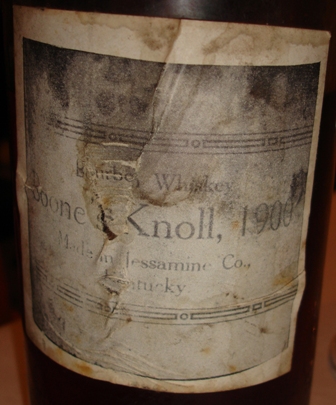
un magnifique Bourbon 1900 bu à l’Astrance en novembre 2006
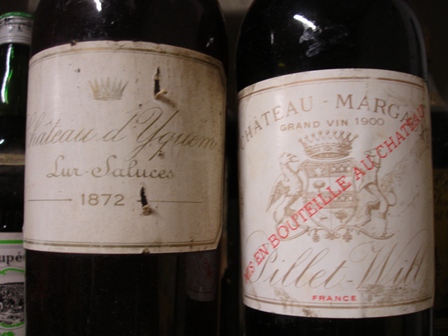
Margaux 1900, ici à côté d’Yquem 1872. C’est une de ces bouteilles que j’ai cassées un jour de malchance…
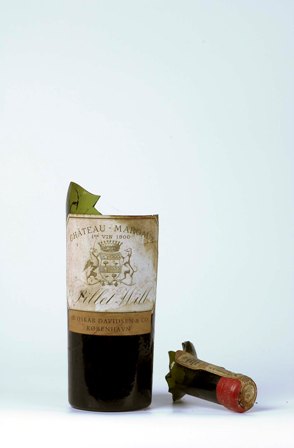
C’est cette photo qui a fait la couverture de mon livre "carnet d’un collectionneur de vins anciens", paru aux éditions Michalon.
On notera la différence entre "premier vin" et "grand vin".
La phrase absconse du bulletin 172 lundi, 27 mars 2006
Lors de l’envoi du bulletin 173 par email, j’ai créé un petit concours pour inciter les lecteurs à lire mes bulletins et à consulter le blog. Voici la formulation :
« Il y avait dans le bulletin 172 une phrase volontairement absconse. Les quatre premiers qui en donneront la clef, avec l’explication exacte, partageront avec moi une Yquem. Pour le plaisir. La solution sera donnée dans une semaine sur le blog. On l’aura compris, c’est pour animer la lecture de ce bulletin et créer le réflexe de consulter le blog. »
Il fallait trouver la phrase. La voici : « Le président de l’automobile club de France déclare ouvert le dîner annuel de l’Union des Grands Crus. Il rappelle, mais avec des mots plus choisis, que Noé fut le premier à faire rougir l’alcootest, et avec un langage fleuri, il nous compte l’histoire de la vigne. Quand au bout de cinq minutes on en est encore à Horus et Osiris, on se dit que la soirée sera longue, mais son discours fait « pschent », ce qui est assez abracadabrantesque, et c’est au tour du président de l’Union des Grands Crus de s’exprimer. »
La clef de l’énigme est la suivante : les interviews de Jacques Chirac le 14 juillet.
Une année il dit que telle ou telle affaire ferait « pschitt ». Une autre année il trouva une question « abracadabrantesque », exhumant un mot de Rimbaud. Le discours de président s’annonçait fort long si l’Egypte prenait tant de temps. Or son discours s’arrête. Il fait pschitt. Comme on parlait de l’Egypte, il fait pschent, puisque pschent est la coiffe des pharaons. Ce brusque arrêt du discours est curieux. Il est donc abracadabrantesque. La logique élyséenne était dans cette phrase.
Les vainqueurs sont trois.
Nous boirons ensemble un vieil Yquem. Je le raconterai.
préposé au chariot lundi, 27 mars 2006
Dans les grands retaurants, il y a le chariot du pain, le chariot du beurre, le chariot des fromages, le chariot des infusions, le chariot des chocolats, le chariot des desserts. Je fais mieux, et avec le sourire, car j’apporte un nouveau chariot, le chariot de Marc Veyrat !!! 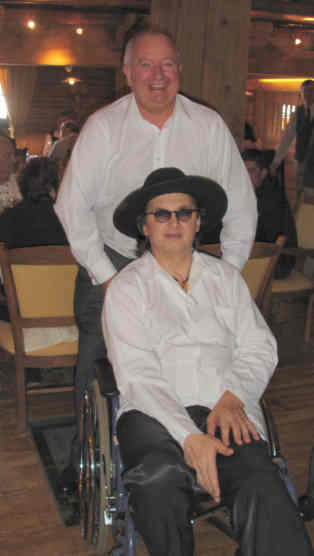
galerie 1901 dimanche, 26 mars 2006
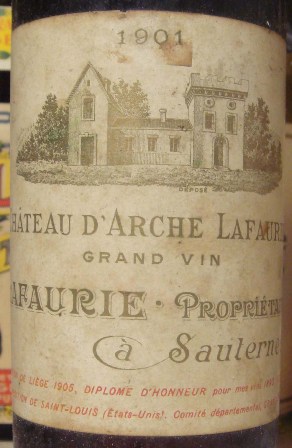
Chateau d’Arche Lafaurie Sauternes 1901. Rareté à ouvrir bientôt.
Dîner de wine-dinners au restaurant de l’hôtel Bristol jeudi, 23 mars 2006
- Champagne Charles Heidsieck 1982
- Champagne Laurent Perrier Grand Siècle
- Gewurztraminer Gustave Lorentz réserve 1966
- Montrachet Comtes Lafon 1990
- La Mission Haut-Brion 1964
- Château Ausone 1953
- Château Coutet Saint-Emilion 1952
- Le Corton Bouchard Père & Fils 1980
- Chambolle Musigny les Amoureuses P. Misserey et Frère 1981
- Chambertin Charles Viénot 1934
- Chateau Margaux #1931
- Haut Sauternes Guillaume 1943
- Château d’Yquem 1936
Le menu préparé par Eric Fréchon et Jérôme Moreau :
Chamalot parmesan, beignets de lotte, cornets de foie gras aux anguilles, maquis.
Bouillon cube de foie gras de canard, langoustines mi cuites au gingembre, coriandre et cébettes.
Topinambour et truffes noires, cuites en croûte de foin, bouillon mousseux au jus de truffe.
Filet de Sole farci aux girolles, sucs d’arête réduit à peine crémé.
Pot au feu de cochon et bœuf, volaille au foie gras, os à moelle et céleri rave.
Fourme d’Ambert
Poire caramélisée cuite à l’étouffée, jus aux zestes de clémentine semi confite, glace à la vanille
Dîner de wine-dinners au restaurant de l’hôtel Bristol jeudi, 23 mars 2006
I arrive by the restaurant of hotel Bristol to open the bottles for a new dinner. The bottles have been delivered one week before and were put standing in the cellar yesterday morning by Jerome Moreau, the efficient sommelier of the place. Some material is waiting for me and I appreciate that, as it shows the commitment of the staff. Ludovic, a junior sommelier will help me and will smell rare scents. This ceremony of opening has become a tradition.
I am extremely disappointed by the three red Bordeaux, which seem tired, which should not be the case. Mission Haut-Brion 1964 is a solid wine. This one has an extraordinary fill in the neck. So, it should be good. I am ready to declare it dead. The Ausone 1953 looks tired, the Coutet 1952 (the Saint-Emilion) looks tired too, but I have more hopes. Added to that, the Sauternes 1943 seems to be weak. I am disappointed, and even more, for a specific reason.
A TV Channel, Monte Carlo TV, will make a subject on my cellar in a few weeks. So, I asked a friend who is a sommelier to make my cellar a little more glamorous, and he found some bottles whose future is compromised. Having hurt a Chateau Margaux whose year could be 1931, he suggested that I drink it rapidly, and two other Bordeaux were in a bad situation and needed to be drunk rapidly too.
If I had added the 3 wounded Bordeaux to sound bottles, it would be OK. But if I add them to wines counting some weak wines, things are not so good. As I had taken with me two spare bottles in case of emergency, I decided to open them. So, instead of having 10 bottles for 10 people, we will have 15 bottles, due to the addition of the 2 of the reserve and the 3 wounded added. We will see that many surprises occurred.
The guests of the dinner arrive precisely at 8 pm and I give the instructions or « rules » in order to enjoy the dinner, while we drink a champagne Charles Heidsieck 1982 that I have added. The colour of the wine is of an elegant peach light gold, the bubble is still lively, and the champagne is a good way to show what happens with old wines which have integrated all their flavours. The small “amuse-bouche” are very spicy, which seems to be a “façon” of the chef. They make appear various aspects of the champagne.
The menu has been composed by Eric Fréchon helped by Jérôme Moreau, and my comments, which were not numerous, have been taken into account.
Here is the menu :
Chamalot parmesan, beignets de lotte, cornets de foie gras aux anguilles, maquis
Bouillon cube de foie gras de canard, langoustines mi cuites au gingembre, coriandre et cébettes
Topinambour et truffes noires, cuites en croûte de foin, bouillon mousseux au jus de truffe
Filet de Sole farci aux girolles, sucs d’arête réduit à peine crémé
Pot au feu de cochon et bœuf, volaille au foie gras, os à moelle et céleri rave
Fourme d’Ambert
Poire caramélisée cuite à l’étouffée, jus aux zestes de clémentine semi confite, glace à la vanille
It was a truly comfortable menu as it was not too provocative, and was designed to help the old wines to shine.
In our group, three people had already attended a previous dinner. We had French, Belgian and Luxemburg people around the table. Many people from business and finance, and a man managing a group of restaurants.
There was a big contrast between the first champagne and the Laurent Perrier cuvee Grand Siècle from a recent release, with wines coming probably from the period 1995 to 1997. If the first was masculine, this one is outrageously feminine, seducing, with an immense power of evocation of white flowers as the ones which accompany the new design of Laurent Perrier. It has the charm of a sophisticated strip tease.
The Gewurztraminer Gustave Lorentz réserve 1966 is one of the greatest surprises of this dinner. The nose was very generous by opening some hours ago, and when drinking it, it is really flashing. It is not a late harvest so some points of dryness are really exciting. It is enigmatic and very successful. On the soup, it shines marvellously. A great wine and a great combination. I heard many “oh” and “ah” as everyone was amazed by this level of quality of a perfectly kept wine.
The Jerusalem artichoke of Eric Fréchon is exceptional. I had said so many nice words on the rare Montrachet Comtes Lafon 1990 that when it appeared, all of us we were surprised. It is a great wine, with a light gold in colour, a nice smell, but it is as if a car was on the first gear and could not go to the second one. We can feel the promise of a great wine, but we have not the true Montrachet that we were expecting.
Eric Fréchon had thought of a provocative choice to associate the course with a white and a red. And I had said yes. So, La Mission Haut-Brion 1964 was served at the same time as the Montrachet. And the surprise came from this wine, which I would have declared dead, and which came back to life due to the oxygen. Of course it was not the most brilliant example of a Mission 1964, but it was really expressive. And the truffles doped it. And as the Montrachet was playing under its category, it helped to make the Mission even more loveable.
On the sole, two wines. Objectively, it is the Château Coutet Saint-Emilion 1952 which is in the logic of the fish course. The wine has suffered. A little roasted, truffle like, it goes very well with the sauce. The Château Ausone 1953 starts slowly. Polite, it begins by being discrete. But when it is installed in the glass, we can see all the charm of this great wine. It is very intelligent, not invading, but sufficiently great to be appreciated by all.
On the “pot au feu”, we will have three Burgundies instead of two, as I had added the Corton.
The Chambolle Musigny les Amoureuses P. Misserey et Frère 1981 is extremely charming and performs largely better than what could be expected. Very young but altogether evolved, it is warmly sympathetic. The Le Corton Bouchard Père & Fils 1980 has a very clear message, as in a Chinese calligraphy. I love these Burgundies. And the Chambertin Charles Viénot 1934 is highly emotional. I had acquired this wine on the public sale of the cellar of Pierre Cardin in Maxim’s, and up to now, every try had been convincing. This wine is perfect. The structure is precise, dense, signalling a truly great wine. What is amazing is that critics could be made to the Bordeaux, even the most noble, and that no critic could be made to the three different Burgundies. This happens once, tonight, and cannot be considered as general.
Then we tried the three added wounded wines. The Chateau Margaux 1931 has been bottled by a merchant some decades ago and has no year on the label. As I wanted to know, we drank it with experts some years ago, and the central idea was 1931. A weak year, but a pleasant wine. And this one, just wounded by a manipulation of my friend was spectacularly good. So, this addition could sweep all the interrogations on the previous Bordeaux. We enjoyed a truly great Margaux.
The two others had not the same presentation. The Lynch-Moussa 1953 was undrinkable, and the Château Trottevieille 1967 could have been tried, but there was no need to insist, so I rejected it.
The Haut Sauternes Guillaume 1943 has a nice colour of a Sauternes of this period. The smell had been discrete and remained in the same stage. But the fourme d’Ambert helped it to appear a little intelligent. It was pleasant for a while.
Now, it is possible to forget anything as the Chateau d’Yquem 1936 is absolutely exceptional. I had already drunk this year, but this bottle is above any of my expectations, and by far. I consider generally that the decade 30ies gave, with the exception of 1937 wines with a low botrytis. But this one is against my analysis. This Yquem is a Yquem full of joy, with fantastic expression of fruits with an orange colour : apricot, mango, some sorts of prunes, yellow peaches, and it is wonderful. It is this type of Yquem that I love, and tonight I loved it more than the last 1937 that I have drunk.
The pear of Eric is very tasty, but does not add anything to this shining Yquem which needs to be drunk alone.
We have voted as it is traditional.
The Yquem won 7 votes as first, the Chambertin 1934 got one vote as first, as is the case for the Laurent-Perrier and the Gewurztraminer.
The consensus of the votes was in favour of Yquem 1936, Chambertin 1934, Gewurztraminer 1966 and Ausone 1953.
My personal vote has been :
– Yquem 1936
– Chambertin 1934
– Gewurztraminer 1966
– Ausone 1953
The bad surprises were the Mission 1964 with a super high fill and the Montrachet Comtes Lafon 1990 for which I do not understand the underperformance.
It appears that the bad performing were not the oldest ones, which gained the best votes.
But it shows that wine collecting is not a quiet hobby.
And it shows too that the oxygenation helped a lot to make some wines better than they would have been with another method. The Coutet 1952 and the Margaux 1931 have benefited from the oxygen.
Eric Fréchon has made a very intelligent cook as he acted to enlarge the quality of the wines. The service has been perfect.
Despite the dissatisfaction that some of my “children” did not perform as I would have liked, this was a great dinner, with, once again, a wonderful and impressive Yquem.